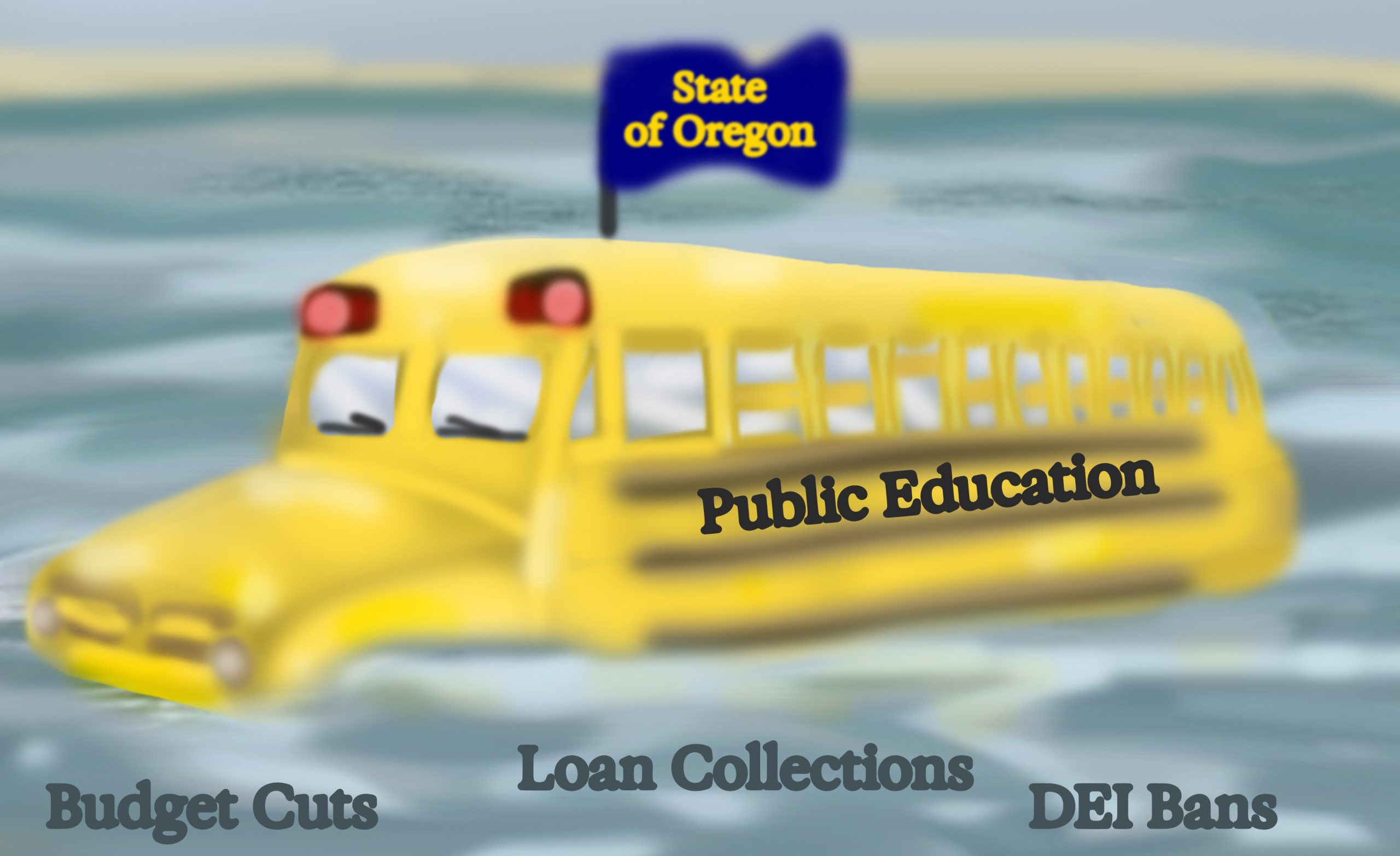Every day, the Trump Administration makes the headlines with yet another horrific policy of discrimination against marginalized communities, threats of economic warfare, mind-bogglingly high tariffs that seemingly change week to week based on the President’s mood and I’m pretty sure Vice President J.D. Vance killed the pope. It’s easy to become overwhelmed with the endless stream of horrors coming from Washington, D.C., as we not-so-slowly descend into a nightmare nostalgia trip back to the ‘50s.
One news story that shouldn’t get lost in the torrent is the Trump Administration’s war on education. On March 20, Trump signed an executive order “calling for the dismantling of the U.S. Department of Education,” per AP News.
The U.S. Department of Education—established by an Act of Congress in 1979—is one more modern institution that Trump and his allies want to tear down brick by brick. The order directed the administration to shutter the department entirely except for its “core necessities,” though no specifics were given as to how this will be done. This uncertainty has already caused havoc in the department, as Secretary of Education and former professional wrestling promoter Linda McMahon dramatically downsized operations by laying off half the department’s staff.
Additionally, Elon Musk’s Department of Government Efficiency (DOGE)—a temporary, ad-hoc billionaire’s playtoy that hardly qualifies as a department, has nothing to do with efficiency and seems to only be interested in scooping out the innards of the federal government until it slowly bleeds out—has cut nearly $900 million from the Department of Education’s Institute of Education Sciences (IES). The Institute—a federal research agency devoted to tracking American students’ progress—had at least 169 contracts terminated by DOGE, including, “long-term studies that track students’ learning from kindergarten through high school, a study evaluating strategies for teaching elementary school reading, and research on the effectiveness of supports for youth with disabilities,” according to AP.
Civil rights enforcement, funding for low income schools, support for students with disabilities and more: all are at risk under the dread triumvirate of Trump, McMahon and Musk.
At the signing ceremony for his executive order, President Trump said of the Education Department, “It’s doing us no good”—except, of course, when it comes to grinding the working class into dust.
Unsurprisingly—but still shocking in its casual cruelty—the Department of Education announced on April 21 that it would resume the “involuntary” collection of student loans in default beginning May 5, according to NBC News. Through the Treasury Department’s offset program, the department said in a statement Monday, government payments “including tax refunds, federal salaries and other benefits” will be withheld from “people with past-due debts to the government.”
After a 30-day warning, wages will be garnished as well.
With an estimated 5.3 million borrowers in default on their loans, this action by the administration is an attack on students and graduates across the country, putting them at greater financial risk for little purpose other than a sadistic whip-crack for the poor.
“We unequivocally condemn the Department of Education’s decision to resume involuntary collections on May 5th, prior to the processing of both outstanding and new Income-Driven Repayment (IDR) applications…” Natalia Abrams, President of the Student Debt Crisis Center, told NBC. “Resuming collections under these circumstances not only ignores these challenges but actively puts vulnerable borrowers at greater financial risk.”
The national consequences for dismantling the Department of Education are catastrophic. Don’t worry, though—Oregon’s getting it bad, too!
In an early indication of the repercussions for resisting the second Trump Administration, Oregon is at risk of losing $735.7 million in K-12 funding from the federal government, or about 7% of state funding for public schools, according to Willamette Week. The potential shortfall comes after the Oregon Department of Education (ODE) refused to sign an April 3 document from the federal government threatening penalties for states that continue to run programs that promote diversity, equity and inclusion (DEI).
ODE Director Dr. Charlene Williams wrote a statement in response to the administration’s demands.
“We are standing up for the rights of all Oregonians and will continue to promote diversity in our schools because we recognize it enhances learning outcomes for all students,” Williams stated. “Threats to this federal funding without lawful authority or established requirements put key programs at risk that students and schools across Oregon depend on every day… There is no circumstance where it is OK to leverage children’s resources as a political tool.”
It’s heartening to see Oregon officials continue to stand up to the federal government in the face of these threats. It’s not OK—that doesn’t mean, unfortunately, that it won’t happen.
According to Willamette Week, “Oregon receives $266.6 million for school meals, $171.3 million in Title I grants, which fund low-income schools, and $149.9 million for special education grants” from federal programs—money that isn’t easily replaced, and may necessitate harsh cuts or state and local tax increases to make up the difference.
It doesn’t stop there. According to OPB, the Department of Education notified the ODE that almost $3.5 million in funds appropriated for the development of literacy and math programs for Oregon students would be rescinded, effective March 28.
“Due to these terminations, these resources won’t be developed and therefore won’t be available to benefit student learning,” said Marc Siegel, ODE Communications Director.
At this rate, dismantling the Department of Education is starting to look more like the dismantling of American education, full stop.
Education isn’t limited to K-12 classrooms or college campuses, either. When it’s not busy gutting the Social Security Administration or smashing the Consumer Financial Protection Bureau into a thousand tiny pieces, DOGE has its sights set on cultural institutions and public education programs that help ordinary people engage with their communities—you know, the kind of thing Elon Musk lies awake at night seething about.
Local museums and libraries—like the Cowlitz County Historical Museum and Vancouver’s Historic Trust—have lost hundreds of grants as the National Endowment for the Humanities faces cuts, per OPB. Youth literacy programs, apprenticeships and public exhibits of all kinds are threatened by cuts to humanities funding.
Brad Richardson, Executive Director of the Clark County Historical Museum, said of the funding loss, “Those types of exhibits, the types of programs that we’re able to do, they evaporate without Humanities Washington,” a nonprofit supported by the National Endowment for the Humanities (NEH).
Trump’s appointment of Keith E. Sonderling to the Institute of Museum and Library Services (IMLS) has even more potential to fatally wound libraries and museums across the country, including here in Oregon. The new acting director appears ready to cut spending wherever he finds it. According to OPB, “federal funding helps pay for things like workforce training, supports pilot programs, and bolsters basic library services such as computer and internet access in rural libraries,” with the IMLS awarding $266 million last year for grants and research funding.
The American Alliance of Museums, a museum advocacy group, issued a statement March 17 stating, “There is no efficiency argument when IMLS represents just 0.0046% of the federal budget, while museums generate $50 billion in economic impact.”
The “efficiency” argument also reveals a fundamental disconnect between the federal government’s aims and the goals of education. A museum doesn’t exist because it’s ‘efficient’, it exists to provide an educational space for the public—to teach us about our past, so we might better understand the present and move into the future more informed. Many of the consequences of the administration’s war on education are immediately apparent, but many more will make themselves known in the years to come, as the slow rotting away of our educational institutions leaves holes that will be left unfilled—or, worse, filled back in by the very people who are doing the digging.






